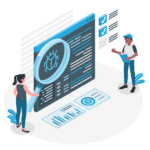Solving the Most Common Obstacles in MVP Development
Do you have the greatest concept for a new product or service since sliced bread? It’s crucial that you make sure your idea has legs before you actually spend valuable resources bringing it to life.
That’s exactly where the notion of a minimum viable product (MVP) comes in. An MVP is a version of a product with a stripped-down feature set. The MVP is perhaps the first time in a product’s development history that it can be said to be “usable”—and only just.
By restricting themselves to developing only the product’s core features, businesses can use the MVP for market research, collecting valuable user feedback. This information helps assess the level of interest of the product’s target audience. If the company decides the idea is worth spending more time and money on, it can use this feedback to enhance future product versions.
Unfortunately, creating an MVP is easier said than done. During the development process, there are a number of barriers and difficulties that even seasoned businesses can encounter. So what should you know if you’re looking to create a minimum viable product?
In this article, we’ll discuss three of the most common obstacles in the MVP development stage and propose a solution for each one. By the end, you’ll be armed with the knowledge you need to make your own MVP software development project a success.
MVP Development Obstacle #1: Not Enough Engineering Resources

The first potential MVP development obstacle is one common to larger organizations: the lack of resources among the engineering team. Many enterprise companies relegate their MVP product development to internal labs or innovation studios while their main engineering team focuses on building the core product.
This approach has a number of issues for MVP software development:
- Without assistance from the engineering team, the MVP lab may not have the dedicated personnel and resources necessary to execute the product vision properly.
- Hiring internally is expensive, and innovation leaders often don’t have the budget to staff their projects fully.
- Even if the budget is available, the hiring, onboarding, and training process can take months—too long for agile businesses that want to get a product to market fast.
Solution: Explore Global Talent
Rather than requiring MVP development to be performed in-house, businesses can look elsewhere for their needs. Situations such as these are ripe for outsourcing, joining forces with a third party that has the necessary software development talent and can hit the ground running.
In particular, offshore and nearshore teams can help fill gaps for MVP development without the costs and lengthy timelines associated with hiring internally. KMS works with teams of skilled, experienced software developers in Vietnam with a proven track record of getting jobs done at a fraction of the cost of hiring in-house developers.
MVP Development Obstacle #2: Budget Cuts Hurt Innovation

When organizations—especially large enterprises—look to tighten budgets, innovation is often the first thing to go. In times of economic uncertainty, many businesses prefer to weather the storm with their existing product offerings rather than spending time and money on speculative new ideas. This scenario can halt the production of MVPs entirely, leaving huge tech companies an open opportunity to push new products and gain more market share.
In other cases, MVP development still moves forward, but the product’s core capabilities are limited or reduced. This can expose the MVP to a negative reception from users or key stakeholders that kills the product shortly after launch. While not all budget cuts are fatal for MVP development, project leaders must be able to work within greater constraints, understanding what is truly important for the product.
Solution: Clearly Define Your Product Vision
The impact of budget cuts on innovation can be curbed if managers and developers work with a clearly defined product vision. This ensures that the project will not run over its timeline or budget, dooming it before it gets off the ground.
Remember that the goal of MVP development is to zero in on the core capabilities that are essential to your product. When budget cuts are on the table, project leaders should prioritize the features to develop accordingly.
Before getting started, clearly outline the software’s critical functionality, nice-to-haves, and features for future development. MVP development partners like KMS can help clients with the planning and road-mapping process so that the project starts off on the right foot.
MVP Development Obstacle #3: Getting Buy-In from Non-Technical Stakeholders

Most enterprises have layers of red tape to navigate before a product idea ever sees the light of day. Unfortunately, many technical leaders—while extremely adept at their roles—don’t have the same expertise in selling the MVP to stakeholders in the organization. If the enterprise itself can’t be convinced of the product’s value, then convincing the target audience will be an even greater challenge.
Securing buy-in from top-level figures is a crucial stage in MVP development because it adds much-needed stability to the project. Having the right executives and managers on your side will ensure that you have the resources and personnel you need to bring the project idea to fruition.
Solution: Select a Business Liaison
It’s important to fill key technical roles on your project, but just as important to select the right business leader. This person must be able to wear several hats throughout the MVP development lifecycle, including:
- Being adept at communicating complex technical information so that non-technical people on the business side can understand.
- Guiding the direction of the MVP project based on the organization’s business goals, ensuring that the development aligns with the enterprise’s larger mission.
- Understanding the product’s market, use cases, and intended audience in order to sell key stakeholders on its value.
Solving Obstacles to MVP Development with KMS Technology
MVP development challenges can be a stumbling block for even the most experienced entrepreneurs. By avoiding the common mistakes above, you’ll be more likely to exit the MVP development process with a successful full-fledged product that will grab the attention of your investors and customers.
Creating an MVP is much easier with the help of a development partner. KMS Technology is a global market leader in the fields of software development, technology consulting, project management, and data analytics. We provide a wide range of IT offerings, including MVP development.
Our list of MVP development services includes:
- Defining product requirements and use cases to establish the best product-market fit.
- Creating high-fidelity prototypes to demonstrate the user experience.
- Building and validating the software’s code base with thorough testing and QA practices.
- Providing long-term support and maintenance and adding new product features.
KMS can help turn your product idea into reality by building an MVP. We’re ready to solve your MVP software development challenges and deliver a high-quality final product that will wow your target audience. Want to learn more? Schedule a free consultation today to discuss your business needs and objectives.









